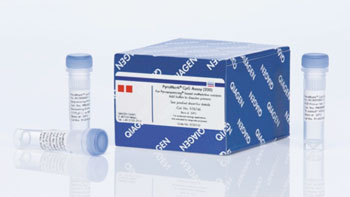Blood Test Predicts Whether Children Will Become Obese
By LabMedica International staff writers
Posted on 07 Apr 2014
A simple blood test, which can analyze DNA, could be used to predict obesity levels in children and the test can assess the levels of epigenetic switches in a gene that regulates fat storage in the body. Posted on 07 Apr 2014
Epigenetic switches take place through a chemical change called DNA methylation, which controls how genes work and is set during early life and can be used to differentiate between children with a high body fat and those with a low body fat when they were older.

Image: PyroMark CpG Assays predesigned for quantification of CpG methylation by Pyrosequencing (Photo courtesy of Qiagen).
Scientists at the University of Southampton (UK) and their colleagues analyzed DNA methylation in the peroxisomal proliferator-γ co-activator-1α promoter gene (PGC1a) in blood from 40 children (20 of each sex) collected annually between 5 and 14 years by pyrosequencing. PCG1α is central to energy homeostasis through regulation of mitochondrial function, pancreatic β-cell function and adipogenesis and is therefore of potential relevance to obesity and cardio-metabolic disease (CMD) risk.
Pyrosequencing was carried out using PyroMark Gold Q96 Reagents on a PyroMark Q96 MD Pyrosequencer (Qiagen; Manchester, UK) and the percentage methylation was calculated. Electrophoretic mobility shift assays (EMSA) were performed using LightShift Chemiluminescent EMSA Kit (Thermo Scientific, Loughborough, UK). The team found that the tests, when carried out on children at five years old, can distinguish between children with adiposity and those with a low body fat when they were older. Results showed that a rise in DNA methylation levels of 10% at five years was associated with up to 12% more body fat at 14 years.
All the results were independent of the child's gender, their amount of physical activity and their timing of puberty. Seven CpG loci were identified that showed no significant temporal change or association with leukocyte populations. The CpG sites are regions of DNA where a cytosine nucleotide occurs next to a guanine nucleotide in the linear sequence of bases along its length.
The authors concluded that their findings support the view that epigenetic marks measured in childhood which exhibit temporal stability may have utility in predicting future disease risk. These findings suggest that temporally stable CpG loci measured in childhood may have utility in predicting CMD risk. Identification of such marks in blood may increase the number of individuals in whom such associations can be tested beyond those for which fetal tissue is available and provide opportunities for further investigation of longitudinal associations and the impact of therapeutic intervention.
Graham C. Burdge, PhD, the lead author of the study said, “It can be difficult to predict when children are very young, which children will put on weight or become obese. It is important to know which children are at risk because help, such as suggestions about their diet, can be offered early and before they start to gain weight.” The study was published on March 12, 2014, in the journal Diabetes.
Related Links:
University of Southampton
Qiagen
Thermo Scientific







 Analyzer.jpg)






